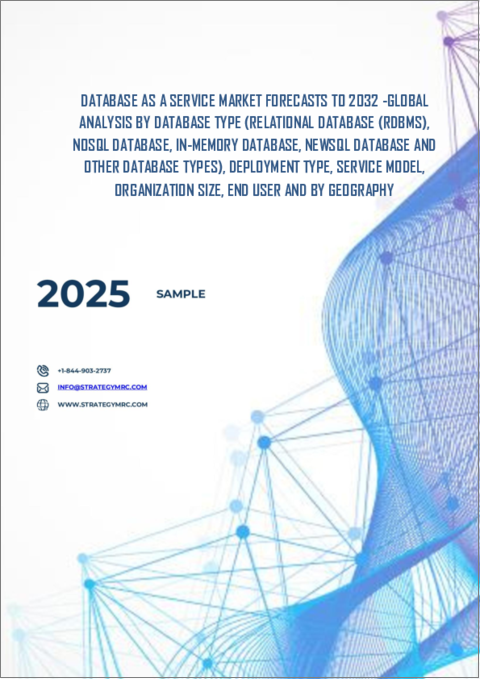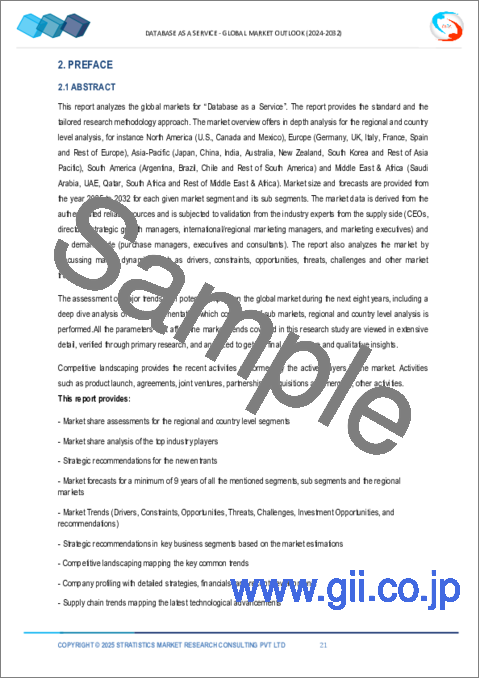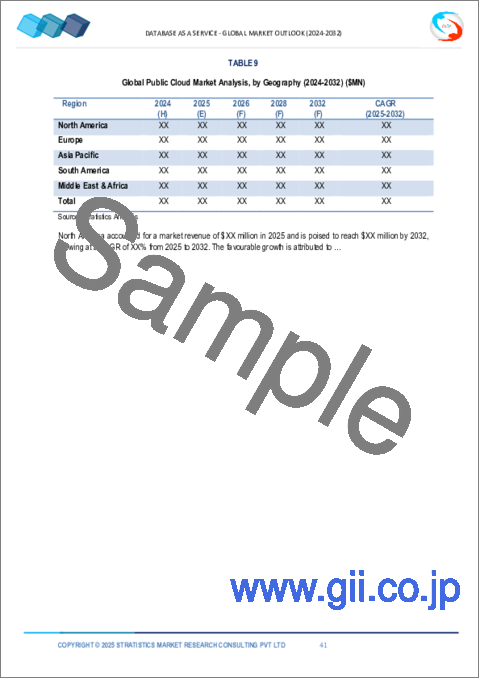|
|
市場調査レポート
商品コード
1744634
DBaas(Database as a Service)市場の2032年までの予測:データベースタイプ別、展開タイプ別、サービスモデル別、組織規模別、エンドユーザー別、地域別の世界分析Database as a Service Market Forecasts to 2032 - Global Analysis By Database Type, Deployment Type, Service Model, Organization Size, End User and By Geography |
||||||
カスタマイズ可能
|
|||||||
| DBaas(Database as a Service)市場の2032年までの予測:データベースタイプ別、展開タイプ別、サービスモデル別、組織規模別、エンドユーザー別、地域別の世界分析 |
|
出版日: 2025年06月06日
発行: Stratistics Market Research Consulting
ページ情報: 英文 200+ Pages
納期: 2~3営業日
|
全表示
- 概要
- 図表
- 目次
Stratistics MRCによると、DBaas(Database as a Service)の世界市場は2025年に340億3,000万米ドルを記録し、予測期間中に15.4%のCAGRで成長し、2032年までには927億5,000万米ドルに達すると予測されています。
DBaas(Database as a Service)と呼ばれるクラウドコンピューティングサービスのパラダイムは、データベースソフトウェアや物理インフラを維持することなく、消費者にデータベースへのアクセスを提供します。DBaaSはオンデマンドでスケーラブルなデータベースホスティングを提供し、サービスプロバイダーはセットアップ、メンテナンス、バックアップを簡単に行うことができます。プロバイダーがインフラ、セキュリティ、アップグレードの面倒を見るため、ユーザーはデータの利用やアプリケーション開発に集中することができます。DBaaSは、オンラインで利用でき、さまざまな種類のデータベースをサポートする、柔軟で手頃な価格の効果的なデータ管理ソリューションを提供します。
高度な技術の統合
予測分析とインテリジェントなデータ管理は、人工知能や機械学習などの技術革新によって可能になりました。クラウドコンピューティングの革新は、企業に費用対効果、柔軟性、容易なアクセスをもたらします。手作業を減らすことで、自動化とオーケストレーションソリューションは運用効率を高めます。改善されたセキュリティ・技術は規制を遵守し、侵害からデータを保護します。これらの技術を組み合わせることで、DBaaSシステムの世界の拡大と広範な導入が促進されます。
データセキュリティとプライバシーへの懸念
クラウド上に機密データを保存する消費者は、データ漏洩や不正アクセスの可能性を懸念しています。GDPRのような厳格なデータ保護法は、DBaaS企業のコンプライアンスを難しくしています。クラウドベースのデータベースシステムに対する信頼は、データの損失や漏えいの心配によって低下しています。こうした懸念から、DBaaSソリューションの導入を見送ったり、敬遠したりする企業もあります。その結果、市場は不透明な需要と採用率の鈍化に直面しています。
ハイブリッドおよびマルチクラウド戦略
組織は、ハイブリッドおよびマルチクラウドアーキテクチャを使用して、異なるクラウド環境にワークロードを分散させることで、パフォーマンスを最適化し、レイテンシを低減することができます。ハイブリッドモデルを活用することで、企業は機密データをプライベートクラウドに保持し、重要度の低いタスクにはパブリッククラウドを使用することで、セキュリティとコンプライアンスを向上させることができます。ベンダーロックインのリスクを低減することで、マルチクラウド戦略は企業に大きなコントロールと交渉力を与えます。スムーズなデータ移動と災害復旧を促進することで、高い可用性と信頼性が保証されます。全体として、さまざまなビジネス要求を満たし、イノベーションを促進することで、ハイブリッドとマルチクラウドの組み合わせはDBaaSの導入を加速します。
経済の不確実性
金利やインフレの変動は運用コストを増加させ、クラウド投資の魅力を低下させます。また、予測不可能な経済状況は企業のリスク回避姿勢を強め、DBaaSのような最新技術の利用を制限します。グローバルな価格モデルは、為替変動によってより難しくなり、顧客の値ごろ感やベンダーの収益性にも影響を与えます。小規模なサプライヤーや新興企業は資金調達に苦労し、競争やイノベーションを阻害しています。一般的に、不安定な経済がもたらす市場の消極性は、DBaaS業界の需要を低下させ、長期的な計画を妨げます。
COVID-19の影響
COVID-19の大流行は、企業がリモートワークやデジタル業務に急速にシフトしたため、DBaas(Database as a Service)市場の成長を著しく加速させました。オンライン活動の増加とリアルタイムのデータアクセスをサポートするため、スケーラブルで柔軟なクラウドベースのデータソリューションに対する需要が急増しました。企業は、コラボレーション、セキュリティ、コスト効率を高めるため、クラウドへの移行を優先しました。初期の混乱にもかかわらず、パンデミックは事業継続におけるDBaaSの重要な役割を浮き彫りにし、世界中でクラウドデータベース技術の普及と技術革新を推進しました。
予測期間中、インメモリデータベースセグメントが最大になる見込み
インメモリデータベースセグメントは、リアルタイム分析やアプリケーションに不可欠な超高速データ処理と低レイテンシアクセスを提供することで、予測期間中に最大の市場シェアを占めると予想されます。データをRAMに直接格納できるため、ディスクI/Oのボトルネックが軽減され、パフォーマンスとスケーラビリティが向上します。このセグメントは、動的なワークロードや複雑なクエリを効率的にサポートし、俊敏性とスピードを求める企業を魅了しています。さらに、クラウドネイティブなソリューションに対する需要の高まりが、DBaaSプラットフォーム内でのインメモリデータベースの採用を後押ししています。全体として、これらの要因は、より優れたユーザーエクスペリエンスと運用効率を実現することで市場の成長を後押ししています。
予測期間中、ヘルスケアおよびライフサイエンス分野のCAGRが最も高くなる見込み
予測期間中、ヘルスケアおよびライフサイエンス分野は、スケーラブルで安全なストレージソリューションを必要とする大量の複雑な患者データや臨床データを生成することで、最も高い成長率を記録すると予測されています。DBaaSは、電子カルテ(EHR)、調査データ、リアルタイムの患者モニタリング情報の効率的な管理を可能にします。DBaaSは、個別化医療、創薬、臨床試験に不可欠な迅速なデータアクセスと分析をサポートします。クラウドベースのデータベースは、ヘルスケアプロバイダーや研究者間のコラボレーションを強化し、意思決定と患者の転帰を改善します。さらに、ヘルスケアにおける規制遵守とデータプライバシー要件が、柔軟でコンプライアンスに優れたDBaaSプラットフォームの採用に拍車をかけています。
最大のシェアを占める地域
予測期間中、アジア太平洋は、インド、中国、東南アジアなどの新興経済圏におけるデジタル変革の取り組みにより、最大の市場シェアを占めると予想されます。スマートフォンの普及、クラウドインフラの開発、データ分析に対する需要の高まりがこの成長を後押ししています。スマートシティやインダストリー4.0に向けた地方自治体の後押しが、DBaaSの採用をさらに促進しています。接続性とデータプライバシー規制の課題にもかかわらず、俊敏性とコスト効率のためにクラウドデータベースへの企業依存が高まっていることから、この地域は世界のDBaaS市場におけるダイナミックな成長拠点として位置づけられています。
CAGRが最も高い地域:
予測期間中、北米地域は金融、ヘルスケア、ITなどの業界でクラウドの導入が進んでおり、CAGRが最も高くなると予測されます。強力な技術インフラとAWS、Microsoft Azure、Google Cloudなどの主要クラウドサービスプロバイダーがこの地域を支配しています。企業は、データへのアクセシビリティとセキュリティを強化するため、スケーラブルでコスト効率の高いデータベース管理ソリューションに注目しています。規制コンプライアンスとデータ主権も市場動向に影響を与えており、ハイブリッドおよびマルチクラウドDBaaSへの投資の増加が地域市場の拡大を後押ししています。
無料のカスタマイズ提供:
本レポートをご購読のお客様には、以下の無料カスタマイズオプションのいずれかをご利用いただけます:
- 企業プロファイル
- 追加市場プレイヤーの包括的プロファイリング(3社まで)
- 主要企業のSWOT分析(3社まで)
- 地域セグメンテーション
- 顧客の関心に応じた主要国の市場推計・予測・CAGR(注:フィージビリティチェックによる)
- 競合ベンチマーキング
- 製品ポートフォリオ、地理的プレゼンス、戦略的提携に基づく主要企業のベンチマーキング
目次
第1章 エグゼクティブサマリー
第2章 序文
- 概要
- ステークホルダー
- 調査範囲
- 調査手法
- データマイニング
- データ分析
- データ検証
- 調査アプローチ
- 調査情報源
- 1次調査情報源
- 2次調査情報源
- 前提条件
第3章 市場動向分析
- 促進要因
- 抑制要因
- 機会
- 脅威
- エンドユーザー分析
- 新興市場
- COVID-19の影響
第4章 ポーターのファイブフォース分析
- 供給企業の交渉力
- 買い手の交渉力
- 代替品の脅威
- 新規参入業者の脅威
- 競争企業間の敵対関係
第5章 世界のDBaas(Database as a Service)市場:データベースタイプ別
- リレーショナルデータベース(RDBMS)
- NoSQLデータベース
- インメモリデータベース
- NewSQLデータベース
- グラフデータベース
- その他のデータベースの種類
第6章 世界のDBaas(Database as a Service)市場:展開タイプ別
- パブリッククラウド
- プライベートクラウド
- ハイブリッドクラウド
第7章 世界のDBaas(Database as a Service)市場:サービスモデル別
- IaaS(Infrastructure as a Service)
- PaaS(Platform as a Service)
第8章 世界のDBaas(Database as a Service)市場:組織規模別
- 中小企業
- 大企業
第9章 世界のDBaas(Database as a Service)市場:エンドユーザー別
- 銀行、金融サービス、保険
- IT・通信
- 小売業・eコマース
- ヘルスケア・ライフサイエンス
- 製造業
- 政府・防衛
- メディア・エンターテイメント
- エネルギー・公益事業
- その他のエンドユーザー
第10章 世界のDBaas(Database as a Service)市場:地域別
- 北米
- 米国
- カナダ
- メキシコ
- 欧州
- ドイツ
- 英国
- イタリア
- フランス
- スペイン
- その他欧州
- アジア太平洋
- 日本
- 中国
- インド
- オーストラリア
- ニュージーランド
- 韓国
- その他アジア太平洋
- 南米
- アルゼンチン
- ブラジル
- チリ
- その他南米
- 中東・アフリカ
- サウジアラビア
- アラブ首長国連邦
- カタール
- 南アフリカ
- その他中東・アフリカ
第11章 主な発展
- 契約、パートナーシップ、コラボレーション、ジョイントベンチャー
- 買収と合併
- 新製品発売
- 事業拡大
- その他の主要戦略
第12章 企業プロファイリング
- Amazon Web Services(AWS)
- Microsoft Azure
- Google Cloud Platform(GCP)
- Oracle Cloud Infrastructure(OCI)
- IBM Cloud
- Alibaba Cloud
- Snowflake
- Databricks
- MongoDB Atlas
- Redis Enterprise
- SingleStore
- DataStax Astra DB
- Neo4j AuraDB
- Couchbase Capella
- ScyllaDB Cloud
- Tessell
- Instaclustr
- Crunchy Bridge
List of Tables
- Table 1 Global Database as a Service Market Outlook, By Region (2024-2032) ($MN)
- Table 2 Global Database as a Service Market Outlook, By Database Type (2024-2032) ($MN)
- Table 3 Global Database as a Service Market Outlook, By Relational Database (RDBMS) (2024-2032) ($MN)
- Table 4 Global Database as a Service Market Outlook, By NoSQL Database (2024-2032) ($MN)
- Table 5 Global Database as a Service Market Outlook, By In-Memory Database (2024-2032) ($MN)
- Table 6 Global Database as a Service Market Outlook, By NewSQL Database (2024-2032) ($MN)
- Table 7 Global Database as a Service Market Outlook, By Graph Database (2024-2032) ($MN)
- Table 8 Global Database as a Service Market Outlook, By Other Database Types (2024-2032) ($MN)
- Table 9 Global Database as a Service Market Outlook, By Deployment Type (2024-2032) ($MN)
- Table 10 Global Database as a Service Market Outlook, By Public Cloud (2024-2032) ($MN)
- Table 11 Global Database as a Service Market Outlook, By Private Cloud (2024-2032) ($MN)
- Table 12 Global Database as a Service Market Outlook, By Hybrid Cloud (2024-2032) ($MN)
- Table 13 Global Database as a Service Market Outlook, By Service Model (2024-2032) ($MN)
- Table 14 Global Database as a Service Market Outlook, By Infrastructure as a Service (IaaS) (2024-2032) ($MN)
- Table 15 Global Database as a Service Market Outlook, By Platform as a Service (PaaS) (2024-2032) ($MN)
- Table 16 Global Database as a Service Market Outlook, By Organization Size (2024-2032) ($MN)
- Table 17 Global Database as a Service Market Outlook, By Small and Medium Enterprises (SMEs) (2024-2032) ($MN)
- Table 18 Global Database as a Service Market Outlook, By Large Enterprises (2024-2032) ($MN)
- Table 19 Global Database as a Service Market Outlook, By End User (2024-2032) ($MN)
- Table 20 Global Database as a Service Market Outlook, By Banking, Financial Services, and Insurance (2024-2032) ($MN)
- Table 21 Global Database as a Service Market Outlook, By IT and Telecom (2024-2032) ($MN)
- Table 22 Global Database as a Service Market Outlook, By Retail and E-commerce (2024-2032) ($MN)
- Table 23 Global Database as a Service Market Outlook, By Healthcare and Life Sciences (2024-2032) ($MN)
- Table 24 Global Database as a Service Market Outlook, By Manufacturing (2024-2032) ($MN)
- Table 25 Global Database as a Service Market Outlook, By Government and Defense (2024-2032) ($MN)
- Table 26 Global Database as a Service Market Outlook, By Media and Entertainment (2024-2032) ($MN)
- Table 27 Global Database as a Service Market Outlook, By Energy and Utilities (2024-2032) ($MN)
- Table 28 Global Database as a Service Market Outlook, By Other End Users (2024-2032) ($MN)
Note: Tables for North America, Europe, APAC, South America, and Middle East & Africa Regions are also represented in the same manner as above.
According to Stratistics MRC, the Global Database as a Service Market is accounted for $34.03 billion in 2025 and is expected to reach $92.75 billion by 2032 growing at a CAGR of 15.4% during the forecast period. A cloud computing service paradigm called Database as a Service (DBaaS) gives consumers access to databases without requiring them to maintain database software or physical infrastructure. It provides on-demand, scalable database hosting, making it simple for the service provider to setup, maintain, and backup. The provider takes care of infrastructure, security, and upgrades, allowing users to concentrate on data usage and application development. DBaaS offers flexible, affordable, and effective data management solutions that are available online and support a variety of database types.
Market Dynamics:
Driver:
Advanced technology integration
Predictive analytics and intelligent data management are made possible by innovations like artificial intelligence and machine learning. Innovations in cloud computing give enterprises cost-effectiveness, flexibility, and easy access. By reducing manual involvement, automation and orchestration solutions increase operational efficiency. Improved security technologies adhere to regulations and protect data from breaches. When combined, these technologies propel the global expansion and broad adoption of DBaaS systems.
Restraint:
Data security and privacy concerns
Consumers who save sensitive data on the cloud are concerned about possible data breaches and illegal access. Strict data protection laws, such as GDPR, make it difficult for DBaaS companies to comply. Trust in cloud-based database systems is diminished by worries about data loss or leaking. Some businesses put off or steer clear of implementing DBaaS solutions because of these worries. As a result, the market is confronted with unclear demand and slower adoption rates.
Opportunity:
Hybrid and multi-cloud strategies
Organisations can optimise performance and lower latency by distributing workloads across different cloud environments using hybrid and multi-cloud architectures. By utilising hybrid models, businesses can improve security and compliance by keeping sensitive data on private clouds and use public clouds for less important tasks. By lowering the risk of vendor lock-in, multi-cloud strategies give companies greater control and bargaining leverage. They guarantee high availability and dependability by facilitating smooth data movement and catastrophe recovery. Overall, by meeting a variety of business demands and spurring innovation, the combination of hybrid and multi-cloud methods speeds up the adoption of DBaaS.
Threat:
Economic uncertainties
Interest rate and inflation fluctuations increase operating costs, which reduces the appeal of cloud investments. Unpredictable economic situations also make businesses more risk averse, which restricts their use of more recent technology like DBaaS. Global pricing models are made more difficult by currency volatility, which also has an impact on client affordability and vendor profitability. Smaller suppliers and startups have trouble getting finance, which stifles competition and innovation. In general, market reluctance brought on by unstable economies reduces demand and interferes with long-term planning in the DBaaS industry.
Covid-19 Impact
The Covid-19 pandemic significantly accelerated the Database as a Service (DBaaS) market growth as businesses rapidly shifted to remote work and digital operations. Demand for scalable, flexible, and cloud-based data solutions surged to support increased online activities and real-time data access. Companies prioritized cloud migration to enhance collaboration, security, and cost-efficiency. Despite initial disruptions, the pandemic highlighted the critical role of DBaaS in business continuity, driving widespread adoption and innovation in cloud database technologies worldwide.
The in-memory database segment is expected to be the largest during the forecast period
The in-memory database segment is expected to account for the largest market share during the forecast period by offering ultra-fast data processing and low-latency access, crucial for real-time analytics and applications. Its ability to store data directly in RAM reduces disk I/O bottlenecks, enhancing performance and scalability. This segment supports dynamic workloads and complex queries efficiently, attracting enterprises seeking agility and speed. Additionally, the growing demand for cloud-native solutions drives adoption of in-memory databases within DBaaS platforms. Overall, these factors boost market growth by enabling better user experiences and operational efficiency.
The healthcare and life sciences segment is expected to have the highest CAGR during the forecast period
Over the forecast period, the healthcare and life sciences segment is predicted to witness the highest growth rate by generating massive volumes of complex patient and clinical data requiring scalable, secure storage solutions. DBaaS enables efficient management of electronic health records (EHRs), research data, and real-time patient monitoring information. It supports rapid data access and analytics crucial for personalized medicine, drug discovery, and clinical trials. Cloud-based databases enhance collaboration among healthcare providers and researchers, improving decision-making and patient outcomes. Additionally, regulatory compliance and data privacy requirements in healthcare fuel adoption of flexible and compliant DBaaS platforms.
Region with largest share:
During the forecast period, the Asia Pacific region is expected to hold the largest market share due to digital transformation initiatives in emerging economies like India, China, and Southeast Asia. Growing smartphone penetration, cloud infrastructure development, and rising demand for data analytics fuel this growth. Local governments' push towards smart cities and Industry 4.0 further stimulates DBaaS adoption. Despite challenges in connectivity and data privacy regulations, increasing enterprise reliance on cloud databases for agility and cost-effectiveness positions the region as a dynamic growth hub in the global DBaaS market.
Region with highest CAGR:
Over the forecast period, the North America region is anticipated to exhibit the highest CAGR by high cloud adoption across industries such as finance, healthcare, and IT. Strong technological infrastructure and major cloud service providers like AWS, Microsoft Azure, and Google Cloud dominate the landscape. Enterprises focus on scalable, cost-efficient database management solutions to enhance data accessibility and security. Regulatory compliance and data sovereignty also influence market trends, with increasing investments in hybrid and multi-cloud DBaaS offerings boosting regional market expansion.
Key players in the market
Some of the key players profiled in the Database as a Service Market include Amazon Web Services (AWS), Microsoft Azure, Google Cloud Platform (GCP), Oracle Cloud Infrastructure (OCI), IBM Cloud, Alibaba Cloud, Snowflake, Databricks, MongoDB Atlas, Redis Enterprise, SingleStore, DataStax Astra DB, Neo4j AuraDB, Couchbase Capella, ScyllaDB Cloud, Tessell, Instaclustr and Crunchy Bridge.
Key Developments:
In December 2024, AWS introduced Amazon Aurora DSQL, a distributed, serverless, PostgreSQL-compatible database designed for high availability and scalability. Aurora DSQL simplifies deployment and management of distributed databases, offering 99.99% availability in a single region and 99.999% in multi-region deployments, thereby reducing operational overhead and enhancing reliability.
In June 2024, AWS partnered with Snorkel AI to assist companies in building production-ready AI models, integrating Snorkel Flow into the AWS ISV program for streamlined deployment. Additionally, AWS entered a five-year agreement with Smarsh to enhance AI compliance solutions in the financial sector, utilizing services like Amazon SageMaker and exploring offerings through Amazon Bedrock and Amazon Q GenAI tools.
In March 2024, Microsoft and Oracle expanded their collaboration to meet growing customer demand for Oracle Database@Azure. This service allows customers to run Oracle database services on Oracle Cloud Infrastructure (OCI) within Microsoft Azure data centers.
Database Types Covered:
- Relational Database (RDBMS)
- NoSQL Database
- In-Memory Database
- NewSQL Database
- Graph Database
- Other Database Types
Deployment Types Covered:
- Public Cloud
- Private Cloud
- Hybrid Cloud
Service Models Covered:
- Infrastructure as a Service (IaaS)
- Platform as a Service (PaaS)
Organization Sizes Covered:
- Small and Medium Enterprises (SMEs)
- Large Enterprises
End Users Covered:
- Banking, Financial Services, and Insurance
- IT and Telecom
- Retail and E-commerce
- Healthcare and Life Sciences
- Manufacturing
- Government and Defense
- Media and Entertainment
- Energy and Utilities
- Other End Users
Regions Covered:
- North America
- US
- Canada
- Mexico
- Europe
- Germany
- UK
- Italy
- France
- Spain
- Rest of Europe
- Asia Pacific
- Japan
- China
- India
- Australia
- New Zealand
- South Korea
- Rest of Asia Pacific
- South America
- Argentina
- Brazil
- Chile
- Rest of South America
- Middle East & Africa
- Saudi Arabia
- UAE
- Qatar
- South Africa
- Rest of Middle East & Africa
What our report offers:
- Market share assessments for the regional and country-level segments
- Strategic recommendations for the new entrants
- Covers Market data for the years 2024, 2025, 2026, 2028, and 2032
- Market Trends (Drivers, Constraints, Opportunities, Threats, Challenges, Investment Opportunities, and recommendations)
- Strategic recommendations in key business segments based on the market estimations
- Competitive landscaping mapping the key common trends
- Company profiling with detailed strategies, financials, and recent developments
- Supply chain trends mapping the latest technological advancements
Free Customization Offerings:
All the customers of this report will be entitled to receive one of the following free customization options:
- Company Profiling
- Comprehensive profiling of additional market players (up to 3)
- SWOT Analysis of key players (up to 3)
- Regional Segmentation
- Market estimations, Forecasts and CAGR of any prominent country as per the client's interest (Note: Depends on feasibility check)
- Competitive Benchmarking
- Benchmarking of key players based on product portfolio, geographical presence, and strategic alliances
Table of Contents
1 Executive Summary
2 Preface
- 2.1 Abstract
- 2.2 Stake Holders
- 2.3 Research Scope
- 2.4 Research Methodology
- 2.4.1 Data Mining
- 2.4.2 Data Analysis
- 2.4.3 Data Validation
- 2.4.4 Research Approach
- 2.5 Research Sources
- 2.5.1 Primary Research Sources
- 2.5.2 Secondary Research Sources
- 2.5.3 Assumptions
3 Market Trend Analysis
- 3.1 Introduction
- 3.2 Drivers
- 3.3 Restraints
- 3.4 Opportunities
- 3.5 Threats
- 3.6 End User Analysis
- 3.7 Emerging Markets
- 3.8 Impact of Covid-19
4 Porters Five Force Analysis
- 4.1 Bargaining power of suppliers
- 4.2 Bargaining power of buyers
- 4.3 Threat of substitutes
- 4.4 Threat of new entrants
- 4.5 Competitive rivalry
5 Global Database as a Service Market, By Database Type
- 5.1 Introduction
- 5.2 Relational Database (RDBMS)
- 5.3 NoSQL Database
- 5.4 In-Memory Database
- 5.5 NewSQL Database
- 5.6 Graph Database
- 5.7 Other Database Types
6 Global Database as a Service Market, By Deployment Type
- 6.1 Introduction
- 6.2 Public Cloud
- 6.3 Private Cloud
- 6.4 Hybrid Cloud
7 Global Database as a Service Market, By Service Model
- 7.1 Introduction
- 7.2 Infrastructure as a Service (IaaS)
- 7.3 Platform as a Service (PaaS)
8 Global Database as a Service Market, By Organization Size
- 8.1 Introduction
- 8.2 Small and Medium Enterprises (SMEs)
- 8.3 Large Enterprises
9 Global Database as a Service Market, By End User
- 9.1 Introduction
- 9.2 Banking, Financial Services, and Insurance
- 9.3 IT and Telecom
- 9.4 Retail and E-commerce
- 9.5 Healthcare and Life Sciences
- 9.6 Manufacturing
- 9.7 Government and Defense
- 9.8 Media and Entertainment
- 9.9 Energy and Utilities
- 9.10 Other End Users
10 Global Database as a Service Market, By Geography
- 10.1 Introduction
- 10.2 North America
- 10.2.1 US
- 10.2.2 Canada
- 10.2.3 Mexico
- 10.3 Europe
- 10.3.1 Germany
- 10.3.2 UK
- 10.3.3 Italy
- 10.3.4 France
- 10.3.5 Spain
- 10.3.6 Rest of Europe
- 10.4 Asia Pacific
- 10.4.1 Japan
- 10.4.2 China
- 10.4.3 India
- 10.4.4 Australia
- 10.4.5 New Zealand
- 10.4.6 South Korea
- 10.4.7 Rest of Asia Pacific
- 10.5 South America
- 10.5.1 Argentina
- 10.5.2 Brazil
- 10.5.3 Chile
- 10.5.4 Rest of South America
- 10.6 Middle East & Africa
- 10.6.1 Saudi Arabia
- 10.6.2 UAE
- 10.6.3 Qatar
- 10.6.4 South Africa
- 10.6.5 Rest of Middle East & Africa
11 Key Developments
- 11.1 Agreements, Partnerships, Collaborations and Joint Ventures
- 11.2 Acquisitions & Mergers
- 11.3 New Product Launch
- 11.4 Expansions
- 11.5 Other Key Strategies
12 Company Profiling
- 12.1 Amazon Web Services (AWS)
- 12.2 Microsoft Azure
- 12.3 Google Cloud Platform (GCP)
- 12.4 Oracle Cloud Infrastructure (OCI)
- 12.5 IBM Cloud
- 12.6 Alibaba Cloud
- 12.7 Snowflake
- 12.8 Databricks
- 12.9 MongoDB Atlas
- 12.10 Redis Enterprise
- 12.11 SingleStore
- 12.12 DataStax Astra DB
- 12.13 Neo4j AuraDB
- 12.14 Couchbase Capella
- 12.15 ScyllaDB Cloud
- 12.16 Tessell
- 12.17 Instaclustr
- 12.18 Crunchy Bridge





